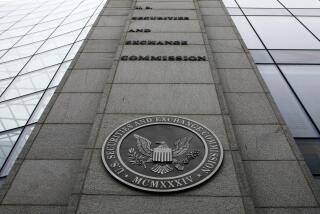Watchdog rejects idea that TARP will turn a profit
WASHINGTON -- The government’s watchdog for the $700-billion Troubled Asset Relief Program on Wednesday disputed suggestions the bailout fund would turn a profit for taxpayers, and warned that many small banks are still struggling to repay.
“It is a widely held misconception that TARP will make a profit,” said a report by Christy Romero, the special inspector general for the TARP program, known as SIGTARP.
The Obama administration has said TARP has turned a profit on about $205 billion injected into banks, but still projects losses for the entire fund.
The report to Congress said that one recent cost estimate put TARP losses at about $68 billion and noted that banks and other financial institutions still owe $118.5 billion. And those figures don’t include the potential harmful effects of the government precedent of wide-scale bailouts.
Policymakers “should not be focused alone on money in and money out. TARP’s costs and legacies involve far more than just dollars and cents,” the report said.
“While TARP and other government responses to the financial crisis may have prevented the immediate collapse of our financial and auto manufacturing industries, and improved stability since 2008, the trade-off is not without profound long-term consequences,” the report continued. “A significant legacy of TARP is increased moral hazard and potentially disastrous consequences associated with institutions deemed ‘too big to fail.”’
Romero and her predecessor in the watchdog position, Neil Barofsky, have been highly critical of the way the Treasury Department has run TARP. And they have pushed back strongly against the administration’s positive stance on TARP’s impact and financial outlook.
Last week, administration officials predicted that the U.S. likely would make a profit of as much as $163 billion over the next decade on all the bailout initiatives that began in 2008 to rescue the financial industry.
That result largely would be due to $179 billion in excess profit from the Federal Reserve over the next 10 years, from its extraordinary expansion of its balance sheet to help bail out the industry and stimulate the economy.
The Treasury Department did not project a profit for the entire TARP program. The administration estimated in February that lifetime losses from TARP would be $67.8 billion, largely because of the GM and Chrysler bailouts, as well as mortgage assistance programs.
Last month, the Congressional Budget Office estimated that TARP would lose $32 billion.
Treasury officials have said the government has made a small profit on the TARP money invested in banks. Most large banks have repaid their money, and the profit comes from dividend payments and the buyback of stock warrants granted to the government.
Still, 351 of the 707 banks that received bailout money had not repaid as of March 31, with taxpayers still on the hook for about $15.7 billion, the report said. Most of those banks -- 330 of them -- received less than $100 million each in bailout money.
“They may be virtually unknown outside their immediate communities, but many of these small banks play a critical role in providing loans and cash management services to local employers as well as services such as checking accounts and auto loans to local residents,” the report said.
It cited Saigon National Bank in Westminster, Calif., which caters to Vietnamese immigrants in Orange County, as one of the smallest banks that has yet to repay its TARP money. The bank has $59 million in assets and has missed 13 dividend payments totaling $265,328 on the $1.6 million it received in bailout money in late 2008.
“Despite the dramatic efforts to expedite the exit of the largest banks from TARP, there appears to be no corresponding plan for community banks’ exit from TARP,” the report said.
Tim Massad, assistant Treasury secretary for financial stability, predicted more banks would repay their bailout money.
“We’ve already recovered more than we invested in TARP’s bank programs through repayments and other income,” he said. “Moving forward, while there’s no one-size-fits-all approach, you’ll continue to see us make significant additional progress winding down the program in the year ahead through repayments, sales, and other methods.”
RELATED:
Former bailout watchdogs criticize AIG tax break
U.S. likely to make a profit on bailouts, Treasury says
U.S. turns a profit on bailout’s mortgage-backed securities







